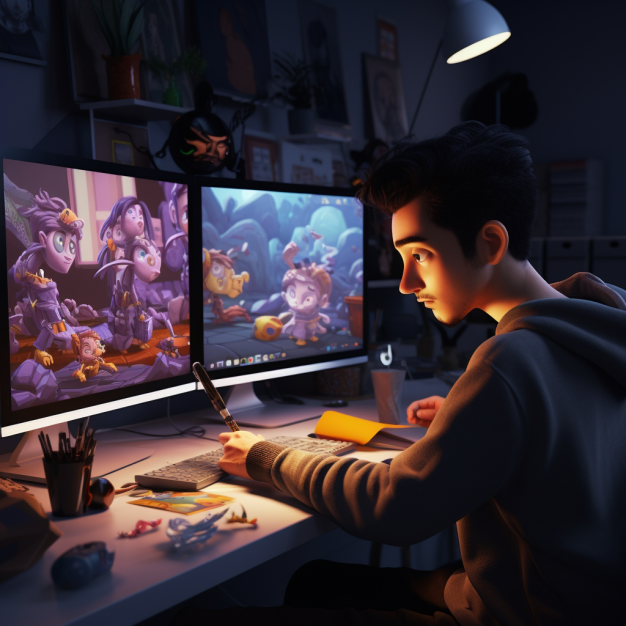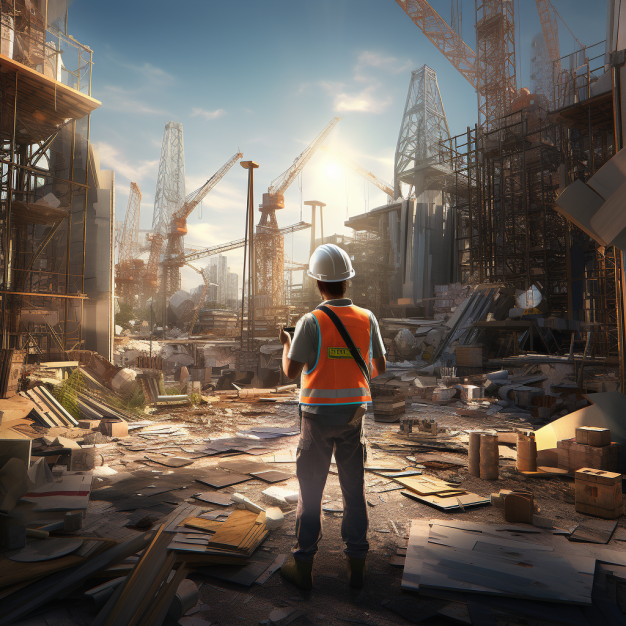
Introduction
What is 3D Rendering Animation?
At its core, 3D rendering animation transforms intricate digital models into captivating visuals. Essentially, it’s the art of turning a computer’s data into striking images or sequences. But, why is it so pivotal today?
The Rise of 3D Rendering in Modern Media
Now, more than ever, 3D rendering dominates our media. From blockbuster movies to immersive video games, it’s everywhere. Moreover, with the surge in virtual reality and augmented reality platforms, this technique is no longer just an option; it’s a necessity. Every day, businesses and creators turn to 3D rendering. Why? Simply put, it elevates storytelling, making tales more engaging and experiences more realistic.
In conclusion, as technology advances, so does the demand for lifelike visuals. And that’s precisely where 3D rendering animation shines. So, let’s delve deeper into this transformative process.
Understanding the Basics
Defining Wireframes in 3D Animation
Ever wondered about the first steps in creating lifelike 3D visuals? It starts with something simple: wireframes. At its core, a wireframe is a skeletal three-dimensional model. It’s where artists plot out the basic structure of an object or scene without any detailed features, textures, or colors.
Why Wireframes Matter
So, why start with something so basic? Firstly, wireframes lay the groundwork. They help designers visualize the shape and scale of a model. Plus, they are essential for mapping out how objects relate to each other in a digital space.
From Skeleton to Full-Fledged Visual
But that’s just the start. As the backbone of 3D rendering, wireframes gradually evolve. They get layered with textures, lighting, and other elements. As a result, they transition from basic structures to detailed, lifelike animations. In essence, they serve as the blueprint, guiding animators through the intricate process of rendering.
To sum up, while wireframes might seem simple, they play a monumental role. They provide the foundation, setting the stage for the stunning 3D visuals we see on screens today.

3D Rendering Animation
Modeling: The Foundation of 3D Rendering
Creating Objects and Scenes in 3D
Dive deep into the world of 3D, and you’ll find modeling at its heart. It’s the art of shaping and crafting digital objects and environments. Think of it as digital sculpting. Artists pull, push, and mold virtual clay to forge detailed 3D objects. Whether it’s a vast landscape or a tiny gadget, modeling breathes life into concepts.
More than Just Shapes
Yet, it’s not just about creating shapes. Good modeling ensures that objects are designed to scale, with accurate proportions. This precision becomes pivotal when these objects interact in a scene.
The Role of Detailed Modeling
Now, you might wonder, why fuss over the details? Here’s the thing. Detailed modeling sets the stage for realism. The creases on a leather jacket, the grain of wooden furniture, or the intricate patterns on a butterfly’s wing – these nuances make animations lifelike. Without this depth, even the best-rendered animation can feel flat and uninspiring.
A Crucial Step Toward Lifelike Animation
In conclusion, modeling stands as the unsung hero of 3D rendering. It ensures that the animations we see are not just visually appealing, but also resonate with a sense of realism. And in a world where audiences seek immersive experiences, detailed modeling is more crucial than ever.
Texturing: Giving Surfaces a Real Feel
Applying Textures to Models
After modeling comes another vital step: texturing. Imagine a sculpted statue. Without color or surface detail, it’s plain and lifeless. Similarly, 3D models need textures for realism. Textures give them color, patterns, and surface details. They transform a smooth 3D shape into a rugged mountain, a fuzzy teddy bear, or a shiny car. In essence, textures add depth and character to models.
UV Mapping: The Blueprint for Textures
Now, applying a texture isn’t as simple as pasting a picture onto a model. This is where UV mapping comes into play. Think of UV mapping as wrapping a gift. The wrapping paper (texture) needs to fit the gift (3D model) perfectly. If not, it looks odd. Similarly, UV mapping ensures textures fit models seamlessly. It’s a process that ‘unwraps’ a 3D model into a 2D plane. Once done, artists can paint details accurately, making sure every texture aligns with the model’s contours.
Bringing Models to Life
In conclusion, texturing, coupled with UV mapping, allows 3D models to come alive. It’s not just about vibrant colors but also about achieving a touch of realism. After all, in the world of animation, it’s these details that captivate the audience. So, next time you admire the intricate patterns on a 3D character’s attire or the realistic rust on a virtual old car, remember the magic of texturing.
Lighting: Setting the Mood and Atmosphere
Different Types of Lights in 3D Rendering
Lighting is crucial. It’s the difference between a flat image and a vibrant scene. In 3D rendering, several types of lights come into play. First, we have ambient lights. These provide general illumination, casting a soft glow without clear sources. Then, there are point lights. Think of them as bulbs. They radiate light from a single point in every direction. Next, spotlights direct light towards specific areas, much like a flashlight. Lastly, directional lights mimic sunlight, casting parallel light rays.
Balancing Realism with Artistic Vision
Now, while lighting adds realism, it also enhances storytelling. Artists often face a balancing act. On one hand, they aim for realistic lighting, replicating how light interacts with surfaces. On the other, they tweak settings to evoke emotions. A gloomy scene might use subdued, blue-tinted lights, while a cheerful one bursts with warmth. Lighting isn’t just about visibility; it’s about mood. So, in every scene, the choice of lighting bridges the gap between reality and the artist’s vision, creating a cohesive narrative.
In Conclusion
In 3D rendering, lighting is both a science and an art. While it roots scenes in reality, it also paints feelings and emotions. Whether it’s the dramatic shadows in a suspenseful scene or the soft glow of a romantic dinner, lighting plays a pivotal role in bringing stories to life.
Shading: The Play of Light on Surfaces
Introduction to Shaders in 3D Rendering
When we talk about shading, we’re diving into the world of shaders. So, what are shaders? Simply put, they’re programs that determine how light interacts with surfaces in 3D rendering. Imagine you’re outside on a sunny day. The way sunlight bounces off your shirt, the shadows it casts, and the subtle reflections on your sunglasses—all these are influenced by shaders in a virtual environment.
The Impact of Shaders on Textures and Scenes
Shaders don’t work alone. In fact, they collaborate closely with textures. While textures define a surface’s appearance—like the pattern on your shirt—shaders define how light plays on that surface. For instance, a velvet texture combined with a specific shader will look soft and absorbent, while the same texture with a different shader might appear glossy or metallic. Consequently, the choice of shader can drastically transform a scene. From making water glisten under the sun to creating the soft sheen on a sculpture, shaders breathe life into textures and elevate the overall visual narrative.
Wrapping Up
In the realm of 3D rendering, shaders wear many hats. They’re both scientists, dictating the laws of light, and artists, painting moods with every shade. Through their partnership with textures, they craft the nuanced visual stories that captivate and inspire.
Rigging & Animation: Bringing Models to Life
Setting the Stage with Rigging
Before any animation kicks off, there’s a crucial step that often goes unnoticed: rigging. Think of rigging as the digital skeleton and joints of our 3D model. Without it, our model would be static, frozen in place. With rigging, we gift it the ability to move, to dance, to run, to express. It’s like fitting a puppet with strings, ready for the puppeteer to bring it to life.
Keyframing and Tweening: The Heartbeat of Animation
Once rigged, the real fun begins: animation. At its core, animation is a play of frames. Keyframes, to be precise. These are specific points in time where we set certain positions or states for our model. Imagine you’re animating a ball bounce. The ball’s highest and lowest points might be your keyframes.
Now, between these keyframes, there’s a magic trick called tweening. Instead of manually setting every frame between two keyframes, tweening automatically fills in these in-between frames. It calculates the ball’s gradual descent and ascent, ensuring a smooth animation. So, with just a few keyframes, animators craft fluid, lifelike motions.
In Conclusion
Rigging and animation are like the heart and soul of 3D rendering. Rigging sets the foundation, enabling our models to move. And then animation breathes life into them, crafting stories frame by frame. It’s here that our models, textured and lit beautifully, find their voice, their rhythm, their essence.
Rendering: The Final Touch
Translating Information into Final Imagery
Rendering is the final, crucial step in our 3D journey. At its core, it’s about taking all the previously set elements – from models to lights, from shaders to animation sequences – and translating them into a polished image or sequence. In essence, the computer calculates how each pixel should look based on all the given data. It’s like baking a cake, where you’ve mixed in all the ingredients and now wait for the oven to work its magic.
Overcoming Rendering Challenges
But rendering isn’t without its hurdles. One of the primary challenges is computation time. High-quality renders, especially for complex scenes, can take hours or even days. Every light bounce, every texture detail, every motion blur has to be calculated. And then, there’s the challenge of ensuring quality. Sometimes, unexpected errors can occur, like unwanted noise in the image or issues with lighting. Overcoming these challenges requires a blend of technical knowledge and artistic insight.
Wrapping It Up
To sum up, rendering is the culmination of all previous stages in 3D animation. It’s the moment when all the hard work pays off, presenting us with a visual treat, be it a still image or an animated sequence. However, like every other stage, it demands patience, expertise, and a keen eye for detail.
Post-Processing: Polishing the Final Image
Color Grading: Setting the Tone
Once rendering completes, post-processing steps in to refine the image. Color grading sits at the forefront of this stage. Simply put, it’s the process of adjusting colors to achieve a specific mood or style. For instance, a warm, golden tone can evoke feelings of nostalgia, while a blue, desaturated look might set a somber mood. It’s amazing how tweaking colors can shift the entire feel of an image.
Effects and Compositing: Layering the Magic
Next up, we have effects and compositing. These processes allow us to layer different elements together. Maybe it’s about adding a CGI character into a real-life scene. Or perhaps, it’s sprinkling some magical effects for that extra sparkle. Compositing ensures these layers merge seamlessly, creating a cohesive visual.
Achieving the Vision with Post-Processing
So, why does post-processing matter so much? Because it’s the final step that truly brings the vision to life. Even with the best 3D models and perfect renders, the image might lack a certain “oomph.” Post-processing adds that finishing touch, refining the image to match the desired look and feel. In essence, it’s the cherry on top of our 3D visualization cake.
The Evolution of 3D Rendering Animation
A Journey Back in Time
It’s hard to believe, but 3D rendering hasn’t always been the cutting-edge process we know today. In its early days, it was a basic and time-consuming task. But as technology advanced, so did rendering techniques. Now, animators and graphic artists employ sophisticated software, enabling them to produce hyper-realistic visuals that were once thought impossible.
Gazing into the Future
And what’s next for 3D rendering? With virtual reality and augmented reality gaining traction, the demand for high-quality 3D visuals is skyrocketing. Innovations in AI and machine learning also hint at a future where rendering might become instantaneous. Indeed, the horizon is gleaming with possibilities.
Conclusion
From Wireframes to Masterpieces
Journeying from a simple wireframe to a stunning rendered animation is truly a marvel. We start with basic structures, much like the skeleton of a building. As we move along, these wireframes get fleshed out, detailed, and refined. With every step, from modeling to texturing, from lighting to shading, the image gets closer to the final vision. It’s a transformative process, akin to watching a caterpillar morph into a butterfly. By the time we reach post-processing, the once rudimentary shapes gleam with life, detail, and depth.
Shaping Our Visual Horizon
3D rendering animation isn’t just about creating pretty pictures. It’s about shaping the very world we see and interact with. Be it movies, games, or even virtual simulations, this technique brings imagination to life. Today, our visual media landscape thrives on it, offering experiences that were once deemed impossible. Every rendered frame tells a story, and behind that story, there’s a team of talented professionals and a host of intricate processes. Through 3D rendering animation, we’ve expanded our horizons, turning the realm of dreams into tangible visuals. What a time to be alive in the world of visual arts!
Intrigued by the magic of 3D rendering animation? Whether you’re considering a project or just looking to learn more, Austin Visuals 3D Animation Studio is here to guide you. Our experts are always ready to shed light on the intricacies of animation. So, if you’re thinking about bringing your vision to life, there’s no better partner. Dive into the world of 3D with us. Reach outAustin Visuals today , and let’s create magic together!
For inquiries or questions Call Us, (512) 591-8024, Email us: [email protected], or use the form below to send us a message. We’re ready to answer any questions you have so that we can deliver your creative project on time and to the highest standard possible.
Have A Project You Want To Discuss? Drop us a line!





